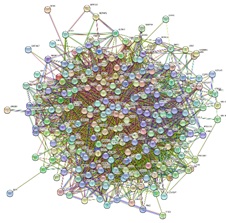A Network Pharmacology of Lemongrass (Cymbopogon citratus) on COVID-19 Cases
Abstract
Various ways and treatment efforts are carried out to avoid the severe impact of COVID-19 cases, one of which is using plants as natural immunomodulatory agents. One of the plants that is proven to act as a natural immunomodulator is lemongrass (Cymbopogon citratus). This study aimed to determine the protein tissue associated with the body's immune system activated by C. citratus. The secondary metabolites of C. citratus were identified using the KNApSAck and Dr. Duke databases. Target proteins associated with plant-secondary metabolite compounds from the SwissTargetPrediction database and immunomodulatory-associated target proteins were obtained from the GeneCards database. The intersected proteins were put into StringDB and analyzed using KEGG to obtain network pharmacology. 98 secondary metabolite compounds of C. citratus were obtained from the database. Proteins associated with C. citratus contain 1096 compounds, and those related to immunomodulators contain 1380 proteins. The intersection results obtained 244 proteins predicted to interact with C. citratus and are related to immunomodulators. From the results of KEGG analysis, five pathways related to C. citratus were obtained, namely PD-L1 expression and PD-1 checkpoint pathway in cancer, Fc epsilon RI signaling pathway, Th17 cell differentiation, T cell receptor signaling pathway, and IL-17 signaling pathway. MAPK 1, MAPK 3, and MAPK 14 proteins are predicted to be in all five related pathways, and Mol 13 compounds are predicted to be able to interact with these three proteins. Thus, it can be concluded that the compound Mol 13 is the compound that plays the most role in acting as an immunomodulator in C. citratus.
References
Daina, A. et al. (2019) ‘SwissTargetPrediction: Updated Data and New Features for Efficient Prediction of Protein Targets of Small Molecules’, Nucleic Acids Res, 47, p. 357-366. doi: 10.1093/nar/gkz382.
Ekins, S. et al. (2007) ‘In Silico Pharmacology for Drug Discovery: Methods for Virtual Ligand Screening and Profiling’, Br J Pharmacol, 152, p. 9-20. doi: 10.1038/sj.bjp.0707305.
Erniati, E. and Ezraneti, R. (2020) ‘Aktivitas Imunomodulator Ekstrak Rumput Laut’ Acta Aquatica: Aquatic Sciences Journal, 7, 79. doi: 10.29103/aa.v7i2.2463.
Ernis, G. et al. (2020) ‘Uji In Vitro Aktivitas Imunomodulator Minyak Atsiri Serai Dapur (Cymbopogon citratus) Terhadap Proliferasi Sel Limfosit Mencit’, BIOEDUSAINS: Jurnal Pendidikan Biologi dan Sains, 4, p. 129-135.
Fujiati, F. et al. (2022) ‘Pemanfaatan Tanaman Herbal Sebagai Imunomodulator Dalam Rangka Meningkatkan Imunitas Bagi Lansia Di Panti Sosial Tresna Werdha Banjabaru’, Jurnal Pengabdian Al-Ikhlas, 7. doi: 10.31602/jpaiuniska.v7i3.6872.
Grabowski, P. and Rappsilber, J. (2019) ‘A Primer on Data Analytics in Functional Genomics: How to Move from Data to Insight?’, Trends Biochem Sci, 44, 21-32. doi: 10.1016/j.tibs.2018.10.010.
Kanehisa, M. et al. (2023) ‘KEGG for Taxonomy-Based Analysis of Pathways and Genomes’, Nucleic Acids Res, 51, p. 587-592. doi: 10.1093/nar/gkac963.
Lena, N. et al. (2023) ‘Analisis Jejaring Farmakologi Tanaman Jati Belanda (Guazuma ulmifolia Lamk.) Sebagai Imunomodulator’, Journal of Islamic Pharmacy, 8, p. 1-6. doi: 10.18860/jip.v8i1.20782.
Morley, J. E. (2020) ‘COVID-19 — The Long Road to Recovery’, Journal of Nutrition, Health and Aging, 24, p. 917-919. doi: 10.1007/s12603-020-1497-y.
Nguyen-Vo, T. H. et al. (2020) ‘Plant Metabolite Databases: From Herbal Medicines to Modern Drug Discovery’, J Chem Inf Model, 60, p. 1101-1110. doi: 10.1021/acs.jcim.9b00826.
Sharma, A. D. and Kaur, I. (2022) ‘GC-FID Based Aromatic Profiling and Molecular Docking Studies of Lemon Grass (Cymbopogon citratus L.) Essential Oil as Novel Therapeutic for SARS-Cov2 Spike Protein’, Arabian Journal of Medicinal and Aromatic Plants, 8, p. 1-20. doi: 10.48347/IMIST.PRSM/ajmap-v8i2.30261.
Stelzer, G. et al. (2016) ‘The GeneCards suite: From Gene Data Mining to Disease Genome Sequence Analyses’, Curr Protoc Bioinformatic, 1, p. 30-33. doi: 10.1002/cpbi.5.
Syauqi, A. (2020) ‘Jalan Panjang Covid-19 (Sebuah Refleksi Dikala Wabah Merajalela Berdampak pada Perekonomian)’, JKUBS: Journal of Chemical Information and Modeling, 1, p. 1-19.
Szklarczyk, D. et al. (2021) ‘Erratum: The STRING Database in 2021: Customizable Protein–Protein Networks, and Functional Characterization of User-Uploaded Gene/Measurement Sets’, Nucleic Acids Research, 49, p. 605-612. doi: 10.1093/nar/gkab835.
Tay, M. Z. et al. (2020) ‘The Trinity of COVID-19: Immunity, Inflammation and Intervention’, Nat Rev Immunol, 20, p. 363-374. doi: 10.1038/s41577-020-0311-8.
Veda, A. I. H. et al. (2023) ‘In Silico Study Potential Secondary Metabolite Candidate of Citronella Grass (Cymbopogon nardus) on Immunity Cases’, Eksakta : Berkala Ilmiah Bidang MIPA, 24, p. 465-475.
Zhang, R. et al. (2019) ‘Network Pharmacology Databases for Traditional Chinese Medicine: Review and Assessment’, Front Pharmacol, 10, p. 1-14. doi: 10.3389/fphar.2019.00123


This work is licensed under a Creative Commons Attribution-ShareAlike 4.0 International License.









